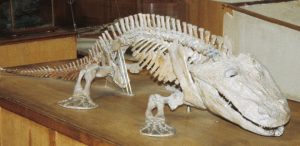
Credit: Christine M. Janis
Early tetrapods, such as Ichthyostega, moved onto land from aquatic environments over 350 million years ago. Skeletal anatomy demonstrates that the front and hind limbs of these early tetrapods correspond to the pectoral and pelvic fins of fishes. Much study has gone into how these primitive tetrapods were able to pull themselves up onto land and move using both their primitive limbs and tail.
A new study led by researchers at Clemson and Carnegie Mellon Universities, the University of California Berkeley, and Georgia Tech, and being presented at the 76th Annual Society of Vertebrate Paleontology Meeting, models the locomotion of early tetrapods using the living mudskipper along with a robot simulator, called the MuddyBot.
This research was recently published in the journal Science (McInroe et al. 2016. Science 353:154-158).
Previous research has shown that some early tetrapods likely could not walk on land like a modern salamander but, instead, had to resort to using their front limbs to raise themselves up and pull themselves along, a locomotion method similar to the living mudskipper called crutching. Therefore, these early land-dwelling vertebrates could not maneuver very well on dry land.
The use of tail movements has long been thought to contribute to locomotion without quantitative analysis. Researchers created the Muddybot to mimic the movement patterns of the mudskipper and to mimic the potential ‘walking’ of these early tetrapods. Results show that the use of coordinated limb and tail movements would have greatly improved locomotion on land, especially on slopes and sandy surfaces that were likely adjacent to the aquatic habitats from which early land invaders emerged.
“Measuring how animals move on natural surfaces can give us new ideas about how vertebrates first invaded land, because it helps us understand the challenges of the habitats they encountered. Using a robot was also important, because we could make it use movements that animals don’t do naturally. This let us understand why some strategies work, and other ones don’t work” said presenter Richard Blob. Although often overlooked, the tail of early tetrapods, which was originally adapted for swimming, could have provided a much needed ‘push’ for the invasion of land.
Note: The above post is reprinted from materials provided by Society of Vertebrate Paleontology.










